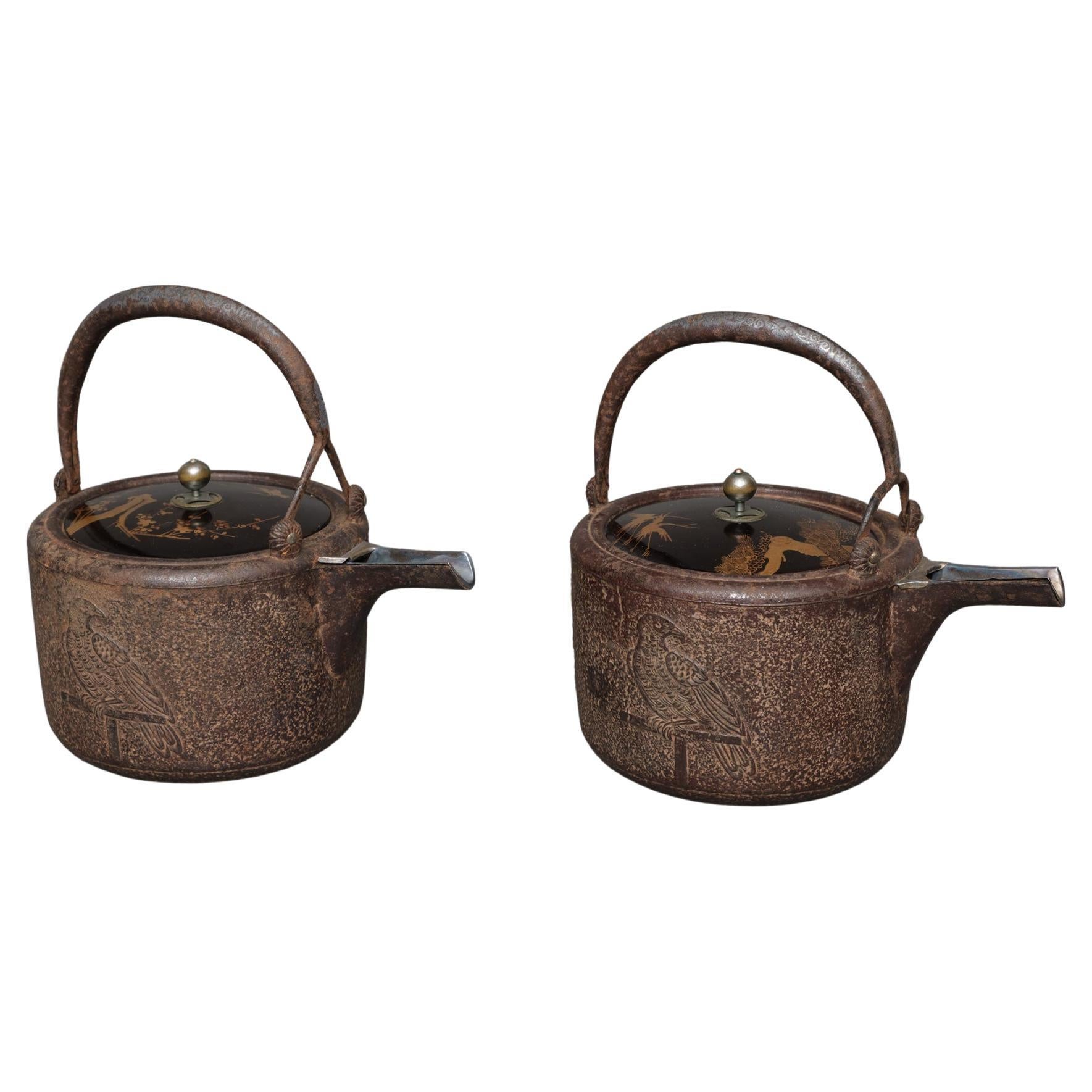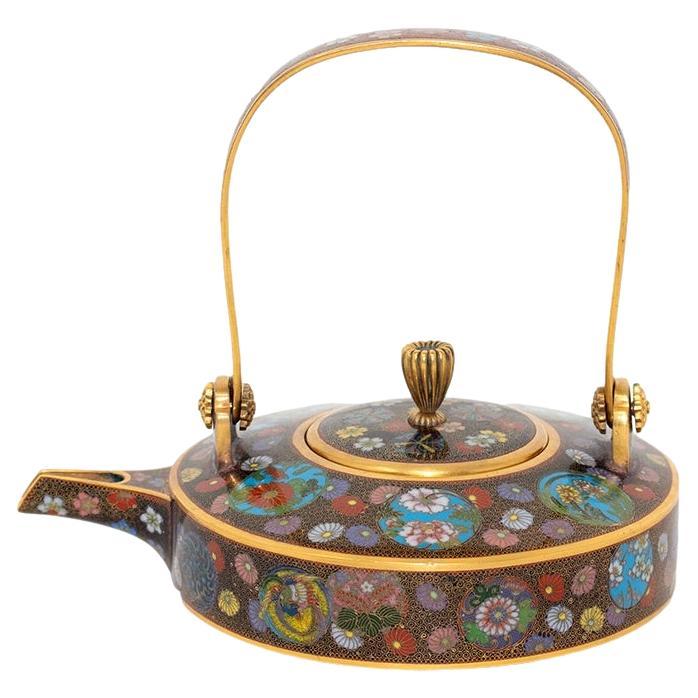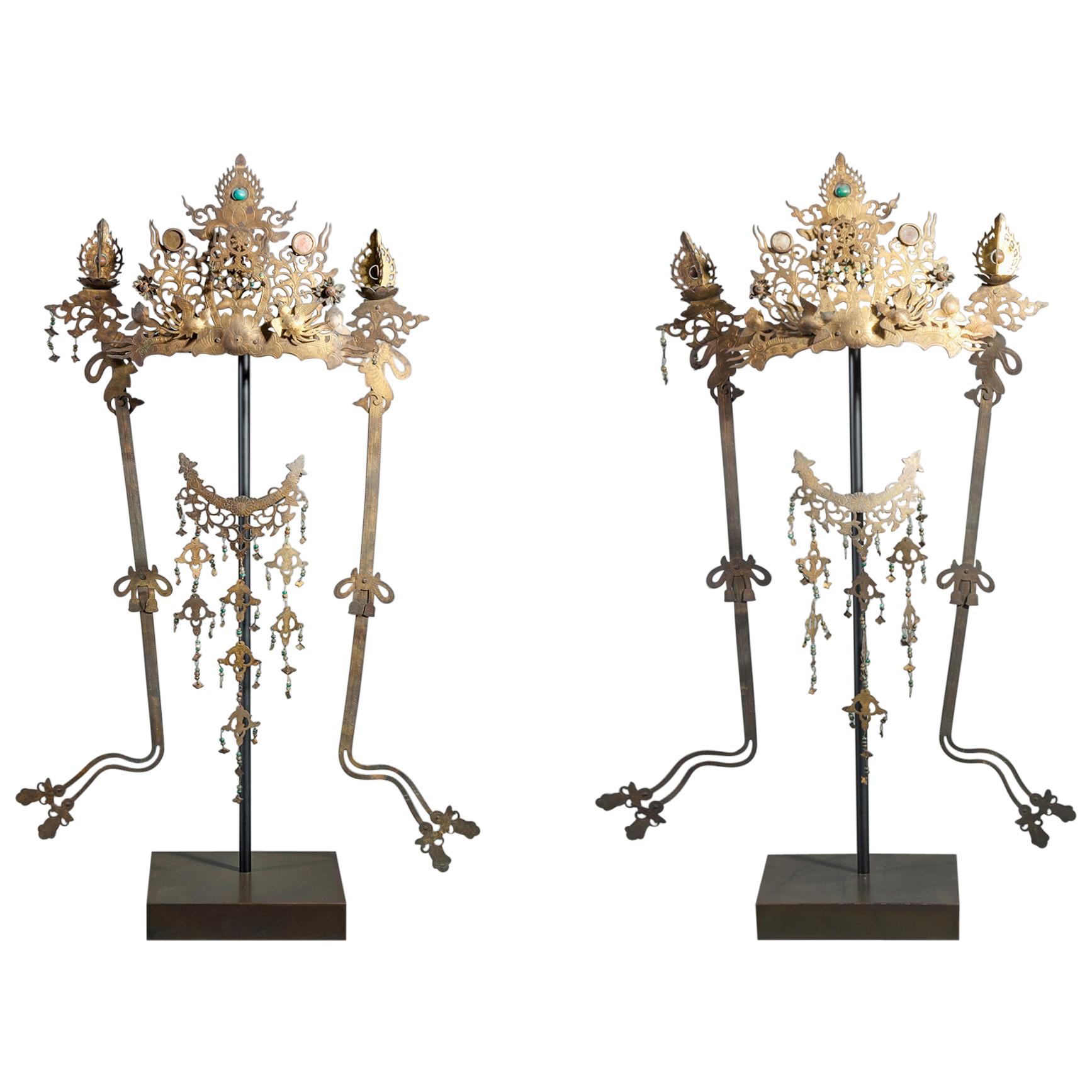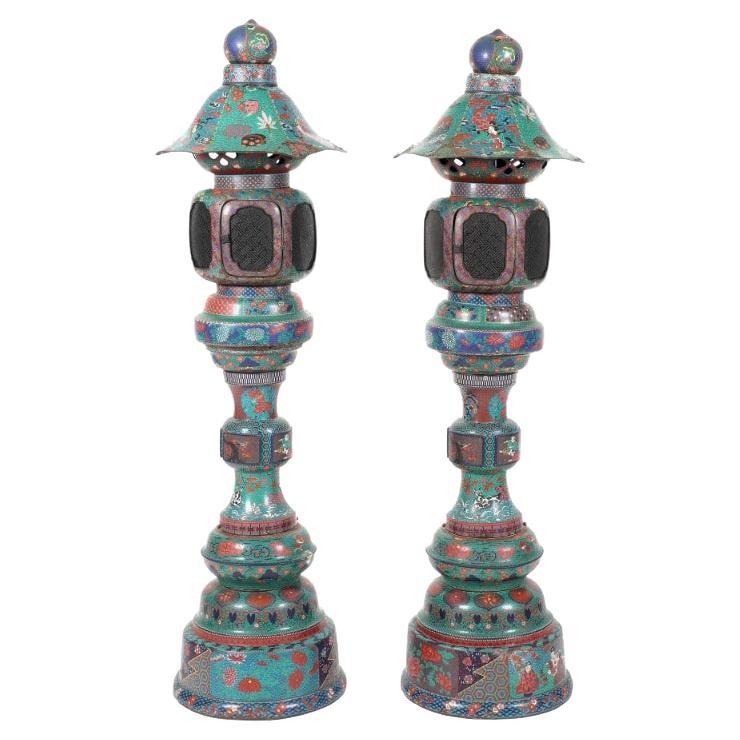Items Similar to Pair Japanese Choshi Sake Ewers
Want more images or videos?
Request additional images or videos from the seller
1 of 11
Pair Japanese Choshi Sake Ewers
About the Item
This is a wonderful pair of 19th century Octagonal Choshi or Sake Ewers that was created during the late Edo or Meiji Period. The Choshi are composed of an Octagonal finely cast iron kettle with and open end spout which differentiates them from the traditional Japanese tea kettle.The body of the Choshi is finely cast with raised shell, wave and chrysanthemum detailing. The brass handle is attached to the body by brass chrysanthemum knobs and small raised iron chrysanthemum holders. The brass lid surmounted by a tiny brass chrysanthemum finial; the kettle is raised on three tiny cast iron feet. Both Choshi are in overall very good condition and retain their wonder natural patina. One finial is slightly bent and loose.
- Dimensions:Height: 7 in (17.78 cm)Width: 8 in (20.32 cm)Depth: 6.5 in (16.51 cm)
- Sold As:Set of 2
- Style:Edo (Of the Period)
- Materials and Techniques:
- Place of Origin:
- Period:
- Date of Manufacture:c. 1860 - 1880
- Condition:Wear consistent with age and use. Overall very good condition with one loose finial to brass lid.
- Seller Location:Pasadena, CA
- Reference Number:
About the Seller
5.0
Gold Seller
These expertly vetted sellers are highly rated and consistently exceed customer expectations.
Established in 1993
1stDibs seller since 2017
225 sales on 1stDibs
Typical response time: <1 hour
- ShippingRetrieving quote...Ships From: Pasadena, CA
- Return PolicyA return for this item may be initiated within 2 days of delivery.
More From This SellerView All
- Japanese Okimo of Standing RabbitLocated in Pasadena, CAThis is an impressive Okimo of a rabbit in a resting position. The bronze is very well cast in the form of a realistic rabbit. The bronze is signed on the bottom of one foot, as shown in photo. It is thought that having a rabbit in the house would bring good luck; meaning: we all need one! This guy would make the perfect desk accessory or book shelf eye-catcher. ***In Japanese culture rabbits are one of the signs of the Japanese zodiac. They are considered lucky as the Japanese kanji...Category
Mid-20th Century Japanese Japonisme Metalwork
MaterialsBronze
- Large Southeast Asian Rain DrumLocated in Pasadena, CAThis is a large example of an early 20th century Southeast Asia ceremonial Rain Drum. The cast bronze drum has acquired a deep desirable patina. The bronze is detailed with abstract designs with a central star. The body of the drum contains tiny sculptures...Category
Early 20th Century Southeast Asian Tribal Metalwork
MaterialsBronze
- Large Glazed Tang-Style Terracotta EwerLocated in Pasadena, CAThis is a stunning large Chinese glazed terracotta dragon-form ewer. The Double Dragons are cast in fine detail. The ewer derives its inspiration fro...Category
Antique Late 19th Century Chinese Chinese Export Delft and Faience
MaterialsTerracotta
- Pair Japanese Lacquer-on-Porcelain VasesLocated in Pasadena, CAThis is a good example of Meiji period lacquer-on-porcelain large statement vases. The maki-e lacquer decoration features birds to one of the sides and ...Category
Antique Late 19th Century Japanese Meiji Ceramics
MaterialsPorcelain, Lacquer
- Japanese ObiLocated in Pasadena, CASuperb example of a c. 1970s Obi. The obi is beautifully woven with multi-colored florals reserves and interlaced cherry blossoms. The reserves are delineated by woven metallic silve...Category
Late 20th Century Japanese Other Textiles
MaterialsSilk
- Japanese Lacquer TraysLocated in Pasadena, CAThis is a wonderful collection of 6 mid-20th century Japanese Lacquer Trays. There is one pair of oxblood red with highlights; one pair of matched oil spot trays and one near pair of...Category
Mid-20th Century Japanese Lacquer
MaterialsWood, Lacquer
You May Also Like
- Pair of Japanese High Quality Chôshi 銚子 'Sake Ewers', Signed 'Sei’ô' 晴王Located in Amsterdam, NLPair of high quality cast iron chôshi (sake ewers) with a detailed lacquered lid. Its body with a refined embossed design of a bird of prey (môchô) perched o...Category
Antique Late 19th Century Japanese Antiquities
MaterialsIron
- Japanese Meiji Period Cloisonne Enamel Sake PotLocated in Newark, EnglandFine Japanese Meiji period cloisonne enamel Sake pot. The Sake pot of rounded form with with clean edges profusely decorated with blossoming flowers throughout upon a black ground ba...Category
Antique Late 19th Century Japanese Meiji Metalwork
MaterialsMetal, Enamel
- Japanese Meiji Bronze Basketweave Pattern Sake PotLocated in Bishop's Stortford, HertfordshireAn exceptional quality Japanese Meiji bronze sake pot decorated with a basket weave patterning dating between 1868 and 1912 and probably made around 1890. The...Category
Antique 1890s Japanese Meiji Metalwork
MaterialsBronze
- Pair of Japanese Abumi Samurai Stirrups with Dragons, c. 1800Located in Chicago, ILInlaid with brass and silver, this extraordinary pair of Japanese bronze stirrups, known as Abumi, were crafted in the Edo period (1603-1868) for use on a Samurai's horse. Each is wo...Category
Antique Early 19th Century Japanese Edo Metalwork
MaterialsSilver, Bronze, Iron
- Pair of Antique Japanese Buddhist Temple Headdress and Necklace OrnamentsLocated in Hudson, NYPair of antique Japanese Buddhist temple headdress and necklace ornaments. Gilt bronze with decorative stones and beads, and intricate metalw...Category
Antique Early 19th Century Japanese Edo Metalwork
MaterialsBronze
- Large Pair of Japanese Cloisonne Enamel Lanterns Attributed to Kaji TsunekichiLocated in New York, NYA Large Pair of Japanese Cloisonne Enamel Lanterns Attributed to Kaji Tsunekichi, Edo Period, 19th century Japanese cloisonne lanterns were made during the Meiji period, from the late 19th to early 20th century, and were often used as decorative lighting fixtures in temples and shrines. Kaji Tsunekichi (1866-1916) was a Japanese cloisonné artist who was active in the late 19th and early 20th centuries. He was born in Tokyo and learned the art of cloisonné from his father, Kaji Sataro, who was also a cloisonné artist. He was renowned for his mastery of the shippo-yaki technique, which involves creating intricate designs with thin wires on a metal base before filling in the spaces with enamel. Tsunekichi was known for his exceptional technical skills and his ability to create intricate designs with vibrant colors. His works often featured nature motifs, such as flowers, birds, and fish, which were rendered in a highly detailed and naturalistic style. He also experimented with new techniques, such as plique-à-jour, a type of cloisonné that creates a stained-glass effect. Tsunekichi's works were highly prized during his lifetime and continue to be sought after by collectors today. He won numerous awards for his cloisonné creations, including a Gold Medal at the 1900 Exposition Universelle in Paris. His works are characterized by their fine wirework, precise enamel application, and attention to detail. Some of Tsunekichi's most famous works include a pair of large cloisonné vases...Category
Antique 19th Century Japanese Edo Metalwork
MaterialsCopper, Enamel
Recently Viewed
View AllMore Ways To Browse
Japanese Minogame
Japanese Iron Sake Kettle
Japanese Sake Kettle
Middle Eastern Dallah
Scandinavian Modern High Back Lounge Chair
Mid Century Modern Kitchen Islands
Dice Furniture
Number 50 Pendant
Vintage Antique French Crystal Chandeliers
Clear Glass Vase Wide
Short Wide Chandelier
Bird Gilt Silver
Wood Grain Nightstand
Scandinavian Blue Green Rug
Indigo China
Inlaid Wood Cabinet Mid Century
19th Century English Writing Table
Pin Top Table





